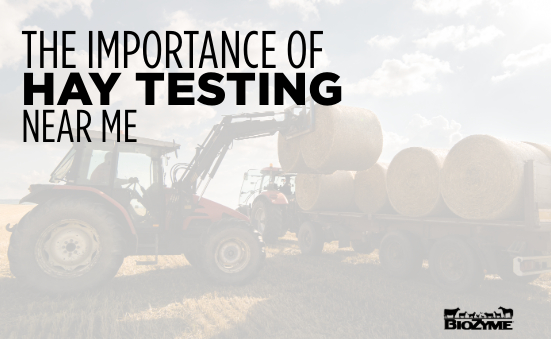We know that BioZyme® dealers wear many hats. You are a salesperson, a consultant in nutrition across species, a supporter of youth livestock and horse events, and a pillar in your community. Let’s add one more role to your over-extended job description: forage sampler. Did you know that hay sampling is a free service that BioZyme offers its customers, who are ultimately your customers?
That’s right! The next time you have a customer ask, “Is there anywhere that does hay testing near me,” your answer will be simple: right here.
Why Test Hay?
Testing hay in the late summer and early fall is imperative to know exactly the nutrient content and makeup. Just like no two BioZyme dealers are the same, no two hay crops are the same, even if they both look similar. There is no way to tell the nutritional makeup of your hay just by looking at it. You could have the most gorgeous group of bales, yet they could all be deficient in protein or energy.
If you or your customers cannot tell the nutrient value of your hay, how will your livestock be getting the proper nutrition. A simple forage analysis can help a customer determine what is missing from their hay, which in turn helps you sell them the added vitamins and minerals to supplement their herd. Forage testing is a win for the customer, you, and their animals. That’s care that comes full circle.
That is why hay testing is so important.
Hay Testing Made Easy
At BioZyme, we want to make your customer’s forage testing experience as simple as possible. That is why we have broken it down into these 5 simple steps.
1. Identify your Hay
It is important for you or your customer to have their hay identified by a lot number, so they know which test results are from which lot. A lot is defined by the field and the cutting it is from.
For instance, a lot from the second cutting from field one would be named Lot 1-2. A first-cutting sample from the third field would be 3-1. It is important to identify the lots when you haul them from the field and store them and continue to know where they are kept.
2. Collect Samples
Once the lots are identified, it is time to collect samples. As a dealer, you or your Area Sales Manager should be prepared to help your customer collect samples. Having an accurate sample is the key to a successful analysis.
We recommend taking 10 samples from each lot, mixing them together, and submitting them as a representative sample of that lot. Be sure to get the samples from as far inside the bale as possible. There are two ways to collect samples: with a probe or by hand.
Sampling with Hay Probe
Reach as far as possible inside the bale with your coring tool. This can be more difficult when bales are wet or when the hay is very mature. In those cases, a spare battery for the drill is helpful, especially if a large number of bales are to be probed.
Sampling Hay by Hand
It helps to use a short pipe to pry open the bale. The goal is to reach inside with your hands open and grasp tightly a handful of hay. You want to try not to strip the leaves off when you grab them, so many small handfuls are better than one large handful.
3. Place Samples Into a 5-gallon Bucket.
Repeat steps 2 and 3 until you have at least 10 samples from 10% of the bales in the lot you are testing. Place all the samples into the same 5-gallon bucket.
After sampling your bales, make sure to pull apart and thoroughly mix the entire sample. Do not rely on the lab to mix your sample.
Place the sample into a re-sealable plastic bag and remove any excess air. It is fine if the bag is not completely full, but you will need approximately 1/2 a quart of material in the bag. You, the BioZyme dealer, should be able to submit the samples.
If you have any questions at all, please contact your Area Sales Manager or a member of the Dealer Action Team. We submit every sample we receive to Dairyland Laboratories.
4. Wait for Results
Once you submit forage samples for testing, we can typically generate results within a week. These results indicate any deficiencies in energy or protein. In addition to knowing the nutrient content of your forages, it is also important to know the amount of each lot of hay you have.
This is especially important when working with the BioZyme Nutrition Team to plan your next steps. This will help them calculate the proper rations and make supplement recommendations moving forward when they know how to match your forage supply to your production calendar.
5. Work with the BioZyme Nutrition Team
We send the forage analysis results to the producer, the dealer, and the ASM. We suggest the dealer and producer work with the nutritionist at BioZyme to calculate and coordinate formulations and supplementations.
Where Can I Find Hay Testing Near Me?
So, next time you hear, “Where can I find hay testing near me?” you will know just how to answer. We hope you are confident that you can pull and collect samples and submit them. That way, you can help your customers find the best nutrition options available.
Sometimes wearing all these hats can be a challenge. But sometimes, it makes you a superhero, too. Offering hay and forage testing is just one way you can offer customer service that will pay your customers’ dividends in the long run.
